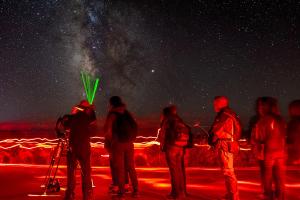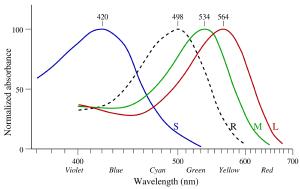Blog
Blinded by the Light
8 April 2015
 National Park Service/Will Pedro
National Park Service/Will PedroOne of the common tools of amateur astronomers is a red light used to see charts and telescope settings. The idea behind the use of red light is to maintain dark adaption for nighttime viewing. While red lights can help in that respect, things are not quite that simple.
Dark adaption comes in two stages. The first is simply the due to the size of our iris. In bright light our iris closes more to let less light into our eyes, while in dark light it opens up to let in light. This shift can happen in a few seconds. You can experience it, for example, when you enter a house on a bright sunny day. For a few moments things look dark, but you’re eyes adjust pretty quickly.
 Wikipedia
WikipediaReal dark adaption happens on a chemical level. Your retina detects light through what are known as rods and cones. The cones come in three types that are differently sensitive to wavelengths, which is how we’re able to detect colors. Rods are more numerous, and are much more sensitive to light. Since rods only come in one type, they aren’t able to give us information about color. Both rods and cones become “blind” to light if they are over exposed. You may have seen this effect when you stare at an image for a while, then look at a white wall or sheet of paper. The after-image you observe is due to the over exposed cones. The chemical reset for cones is fairly quick, so after a few minutes the after-image will fade. For rods, however, the chemical reset can take half an hour or more.
During daylight hours, your rods are over exposed, and so are less efficient. As light gets dimmer, a chemical change allows them to become even more sensitive, and your eyes become dark adapted. If you’ve ever been camping, you might have noticed that as dusk falls the green leaves will appear brighter. This is actually due to your rods becoming dark adapted. Rods are most sensitive at around 500 nanometers, which is in the green to cyan range of the spectrum. In the truly dim light of a dark starry night, your rods become highly sensitive, and the night sky comes alive.
So what does this have to do with red lights? It only takes a brief exposure to bright light for your rods to over expose. Once that happens, you have a half hour or more to regain dark sensitivity, which can seriously hamper your astronomy experience. Since rods are less sensitive to red light (below 650 nanometers) you can use a red light source to view things without ruining your night vision. However it has to be the right kind of red light. Simply taping a red filter over a flashlight isn’t a great solution. Cheap filters don’t block other colors very well, so a bright flashlight with a red filter can still ruin your evening. There are red LED lights and properly filtered red flashlights that are made for astronomical viewing, and these are much more useful. Even then, you don’t want your light source to be too bright.
Although red lights are most commonly used, another solution is to use a cyan-green light. Since this is the region where rods are most sensitive, that might seem counter intuitive, but it’s that sensitivity that makes it useful. Since rods are most sensitive in that color range, you can use a very dim light, and still see things. As long as the light is dim, it won’t over expose your eyes, and your night vision will be maintained.
The best method to preserve dark sensitivity is to simply not use any light source at all. Find a dark place under a dark sky, and simply watch the stars. If you’re patient, the sky will seem to gradually brighten and you’ll be amazed at what you can see.